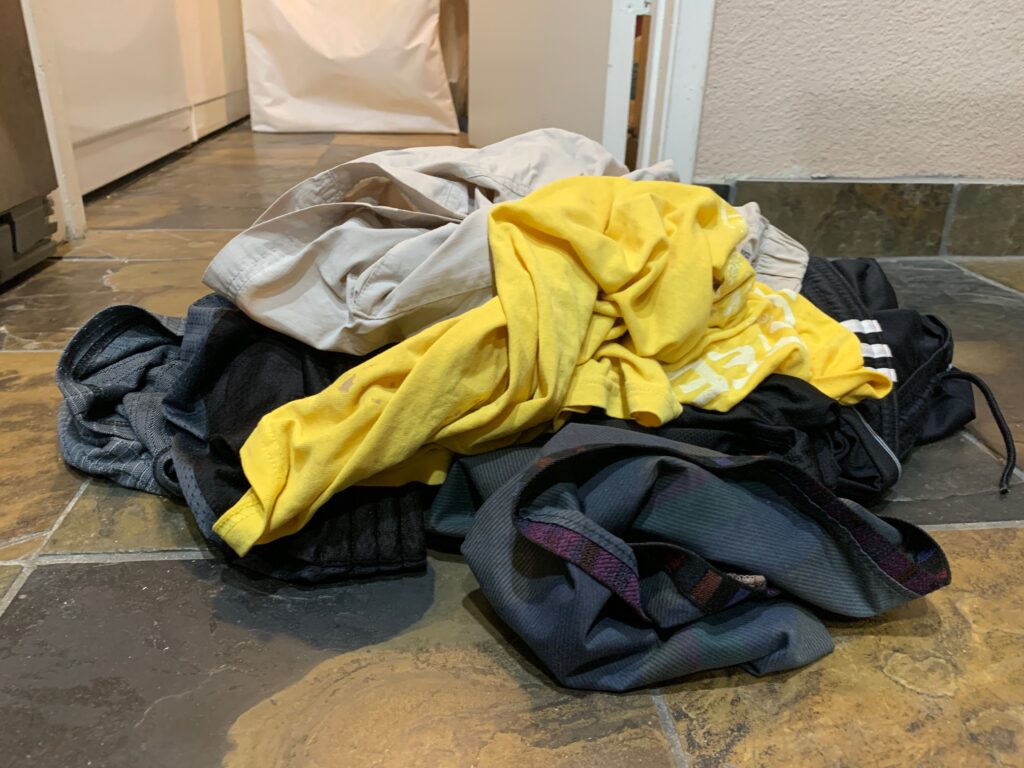Highlights
Our laundry hack is to hand wash and hang dry our clothes every night. This allows us to travel months at a time with just hand carry bags.
Description


We have traveled anywhere between a month to nine months with just a carry-on. Traveling with just a carry-on has many advantages and we are very happy to travel in a minimal way.
We are able to limit our luggage to just a carry-on because we do not bring a lot of clothes. The amount of clothes we bring would not even fill a washing machine. Hence, we do our own laundry and do it every night.
Washing a day’s clothing does not take much time. Normally, we just have two items to wash – underwear and a t-shirt or blouse worn during the day. At most, it would be four items if we include socks and a pair of pants or shorts. So, doing laundry every night should not take long and does not even feel like a big chore.
The biggest challenge of doing our own laundry is not the manual washing, but making sure it dries overnight. We have learned a few things to ensure that our washed clothes will be ready to pack by morning.
Here, we describe our laundry hack, step by step, that has worked well for us.
Hand Washing


Hand washing is the only way to get clean clothes the following day. This YouTube video shows how we hand wash our clothes – wet, soap, rub and rinse. Some videos indicate that rubbing would weaken the fibers. Intuitively, that may be so. But I have shirts that I have been hand washing for the last five years of travel and have not yet developed any holes.
We skip any soaking unless we have time. Soaking takes away air drying time plus we would have to come back later to finish it. We rather get it done and over with so that we could enjoy the rest of the day or evening.
Soap
We use whatever soap is available to us. It does not need to be laundry detergent. Bath or dish soap would work. We even used shampoo and it works well.
In reality, the soap is there to lift the stains from the fabric. You don’t really need soap if your clothing is not stained. Although using soap will make your clothes smell nice, water alone will prevent it from smelling.
A thorough water rinse removes sweat from the fiber. Sweat that has dried is what makes clothes stink. I know this from backpacking in the wilderness. People that wore the same clothes everyday without rinsing emanated a pungent smell that you would not want to take a whiff of. I’ve backpack in the wilderness for 25 consecutive days and wore the same t-shirt every day. But I washed myself and gave my shirt a good rinsing with river or lake water every night. It never stank.
Do You Need A Sink?
No. A sink is nice as it makes rinsing easy but is not totally necessary. We washed our clothes under the shower without any problems.
Rinsing
We rinse three to four times until the water from the clothes is no more bubbly. Wringing does take a bit of effort, especially the last one as you would want to remove as much water as possible to facilitate air drying.
Some videos indicate that wringing weakens the clothes fiber. We have not seen any evidence of this.
Drying
Pre-Drying


Pre-drying with a towel is a great way to make the clothes dry quicker. A towel removes additional water from the wet clothes. Less water means quicker drying time.
Unfortunately, most accommodations do not provide extra towels that we could use for pre-drying. We skip pre-drying with a towel and instead hang the clothes on a clothesline.
Some synthetic fabrics retain moisture no matter how hard we wring it. In this case, we hang it using a hanger. The water then migrates down the fabric. After 30 minutes or so, the bottom half of the clothing is wetter than the upper half. So we wring out the excess water from the bottom half. We do this twice before air-dying it on the clothesline.
Air Flow


The secret to air drying is air flow. Air flow removes the fabric moisture. Even cold air from an air conditioner would dry wet clothes. So we always place our clothes in front of the air vent or return grill to ensure that it gets air flow.
An electric fan also works well. We never had the occasion where we had to pack any wet clothes when there was air flow inside our room.
Clothesline
Some hotels do not provide enough hangers to use for drying. Also, there is not much place to hang the hangers except in the cabinet. Drying inside a cabinet does not work well unless it is a heated cabinet. A cabinet is a small enclosed space. A small space will become humid real quick which would slow down the drying process. It is like drying clothes during a storm.


We always bring a clothesline when we travel. Ours is about 20 feet of paracord. This allows us to string a clothesline across most hotel rooms. One end of the clothesline would have a loop using the secure but easy to untie Bowline knot.
The loop allows the clothesline to be easily hooked to a tie-on point (more later).
We have a couple of clean shoelaces (primarily used as cordage) to extend the clothesline in larger rooms. We tie the paracord and the shoelaces together using the Sheet Bend knot. It is a secure knot that is easy to tie and untie.
Tie-on Points


Next challenge in putting up a clothesline is finding the tie-on points. There is almost always one tie-on point like cabinet and door hinges. The challenging part is finding the tie-on point for the other end of the clothesline.
Usually, hotels would have a window at the opposite end of the room. Windows will have curtains and the curtains will either be on a rod or track. Tying on the curtain rod holder is straightforward. It is more challenging to tie-on to a track that is mounted on the ceiling.


We used to insert one jaw of our 1-inch spring clamps in the track. We insert two or three clamps to hold the weight. Lately, we have been using circle carabiner and it works great. Still, we do not put a lot of weight on the clothesline as those runners are plastic.




Knots
Besides the Bowline and Sheet Bend knots, we use the modified Marlinspike hitch and taut-line hitch. The modified Marlinspike hitch is used as a quick release mechanism. It also speeds up the tie-on process at Bowline end of the line. The taunt-line hitch is used at the free end and is also easy to untie. The taunt-line hitch allows for easy clothesline tension adjustment.
Hanging The Clothes On The Clothesline


We use small clips to secure our clothing on the clothesline.
Putting Away The Clothesline
Twenty feet of paracord may not be long, but stowing it away can be messy if not properly tied for storage. This video shows how we store our paracord so it is neat and tangle free when deployed.
Hair Dryer
If our hotel room does not have any air flow (as in no AC unit), we use a hair dryer to pre-dry the wet clothes before letting it air dry on the clothesline overnight. A hair dryer is also our last resort if we are unable to string a clothesline.
Summary
Hand washing soiled clothes every night is quick, easy and does not even feel like a chore. This also allowed us to shrink our luggage to just a hand carry.
Hand washing involves wetting, soaping, gentle fabric rubbing and rinsing. Any soap works. Perhaps rinsing is the most important as it removes the dried sweat from the fabric. Dried sweat is what causes fabrics to stink.
Air flow is crucial to this laundry hack. Without air flow, most fabrics, even quick dry fabrics would not completely dry overnight. Fortunately, most hotels have hair dryers to finish the job.
A paracord serves as a sturdy clothesline and can be deployed inside the hotel room. A typical hotel room has at least one tie-on point like door or cabinet hinges. Plastic clamps and carabiners come handy for creating a tie-on point. Small clothespins are also vital so that clothes can be hung to maximize the surface area exposed to air drying.
With this laundry hack, we do not want to travel any other way. We do not need a laundromat and it also allows us to experience a simple and minimalistic way of travel.

